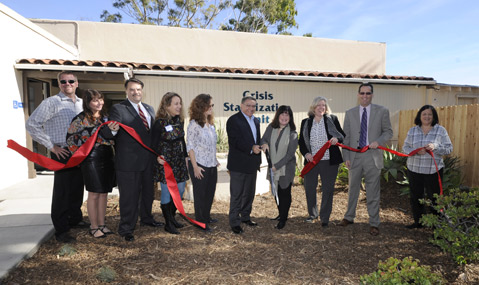Filling a Mental Health Missing Link
County Opens New Crisis Stabilization Unit

In the first three months of 2015, no fewer than 1,111 county residents — deemed so mentally ill they posed a threat to themselves or to others — were shipped to the Aurora Vista del Mar facility in Ventura County because all of Santa Barbara’s in-patient beds were full. For the same period the previous year, the number of patients was 1,219. Combined, that’s nearly three times more than the number of psychiatric patients whom county mental-health workers could shoehorn into Santa Barbara’s chronically bed-deficient Psychiatric Health Facility (PHF).
Given that each bed-night at Vista del Mar costs the county’s Department of Alcohol, Drug and Mental Health Services (ADMHS) $850, it’s little wonder the county has been spending $7 million a year to treat Santa Barbara’s mentally ill out of county and that the department has been running over its allotted budget. With this context in mind, the euphoric reception with which three county supervisors and a host of high-ranking mental-health administrators greeted last week’s grand opening of a small, short-term crisis-intervention facility made sense.
“This is the most exciting day, I believe, for the county,” declared Supervisor Janet Wolf, in whose district the new Crisis Stabilization Unit (CSU) is located. “It is critical.” The idea is that the CSU — located at the county’s mental- health campus off Calle Real — will provide a temporary cooling-off space for individuals who find themselves in severe mental-health- meltdown mode. On hand will be a team of psychiatric nurses, peer counselors, and social workers, as well as a psychiatrist on call 24 hours a day.
Those referred to the CSU will find a kitchen, food, showers, secure storage space, TV sets, online access, and eight broad-in-the-beam chairs — “We call them chairs, not beds,” explained mental-health administrator Dr. Leslie Lundt — that fold down into quasi-beds much like first-class airline seats. For those too agitated for a group setting, two quiet rooms are available. Referral to the CSU is strictly voluntary, meaning those who find themselves there are free to leave.
In the menu of mental-health options, the CSU is a relatively recent invention throughout California. The hope is that the CSU will reduce the obvious strain on the county’s Psychiatric Health Facility, so chronically overwhelmed that numerous grand juries over the past 30 years have seen fit to excoriate its paltry 16 beds. Complicating the picture, the past two years have witnessed a dramatic, if mysterious, spike in the demand for PHF beds by criminal defendants deemed by Santa Barbara judges “incompetent to stand trial,” meaning they’re not psychologically stable enough to assist in their own defense. What is causing this surge remains the subject of more conjecture than actual knowledge, but Santa Barbara’s pattern is in accord with statewide trends.
Despite the plethora of such critical reports, the number of PHF beds has not increased — and will not — mostly for reasons relating to cost and prohibitive licensing restrictions. In recent years, county mental-health administrators have sought instead to expand the range of intermediate pre-PHF options. In addition, ADMHS has expanded the number of teams dispatched to find and respond to people in crisis. The number of cases to which these teams responded nearly tripled from 2013 to 2014, from 2,248 to 7,087. Based on preliminary statistics for this year, 2015 could eclipse that by another 25 percent.
The new CSU will limit referred patients to no more than 23 hours. In that time, vowed ADMHS director Alice Gleghorn, “We will connect people with the available services.” Key among these is a new eight-bed residential treatment facility — La Morada — that opened in July. La Morada is licensed to accept patients for up to 30 days. From inception to completion, the new CSU — funded with a state grant — took one year to complete, which in the geologic time frame of government bureaucracies qualifies as a nanosecond.
The other benefit touted by CSU proponents is the reduced strain inflicted on area emergency rooms by the severely mentally ill awaiting a diagnosis to determine if they’re eligible for the PHF. For patients to meet the threshold for a 5150 hold, doctors must find they pose a threat to themselves or others. Emergency rooms throughout the state and country have reported a significant increase in demand in recent years. Cottage Hospital has hardly been immune. Although emergency-room records from Cottage Hospital combine 5150 examinations with substance-abuse cases, they do provide a definite, if imperfect, sense of the problem’s growing magnitude. In 2010, Cottage reported 2,072 such visits. This year — with nearly eight weeks left — there have already been 2,731.
For people in mental-health crisis, emergency rooms can exacerbate their trauma. Lengthy waits contribute to behavior problems, as well. Beginning this July, Cottage took steps to expand mental-health treatment in its downtown emergency room, offering a separate space and personnel trained to provide psychiatric care. What difference the CSU will actually make has yet to be determined. “That is the $64 million question,” said Dr. Paul Erickson, who heads Cottage’s psychiatric wing.



